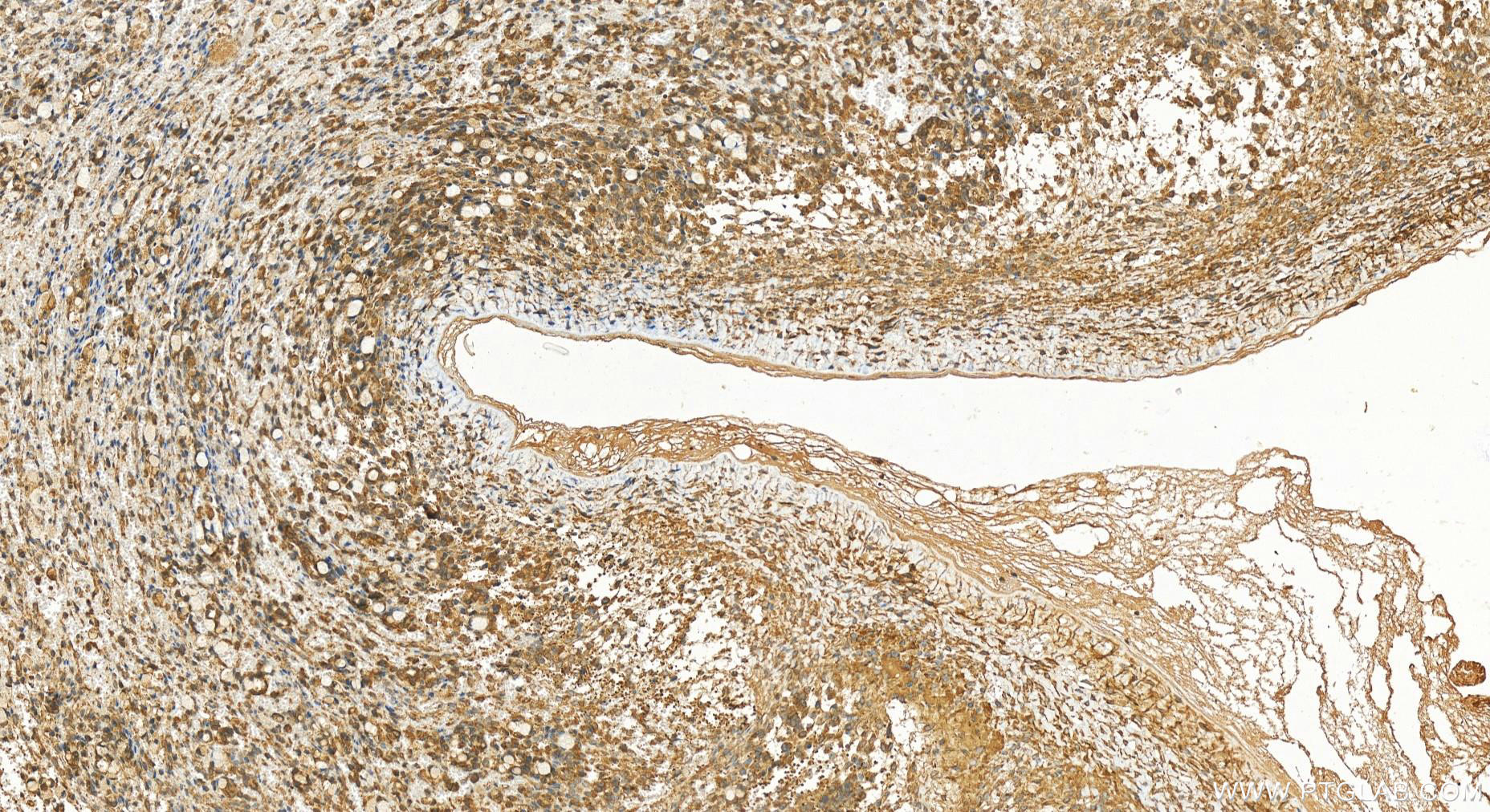Tested Applications
| Positive WB detected in | HT-29 cells, HeLa cells, HepG2 cells, mouse brain tissue, rat brain tissue |
| Positive IHC detected in | human intrahepatic cholangiocarcinoma tissue, human ovary cancer tissue Note: suggested antigen retrieval with TE buffer pH 9.0; (*) Alternatively, antigen retrieval may be performed with citrate buffer pH 6.0 |
Recommended dilution
| Application | Dilution |
|---|---|
| Western Blot (WB) | WB : 1:1000-1:4000 |
| Immunohistochemistry (IHC) | IHC : 1:50-1:500 |
| It is recommended that this reagent should be titrated in each testing system to obtain optimal results. | |
| Sample-dependent, Check data in validation data gallery. | |
Published Applications
| WB | See 7 publications below |
Product Information
17905-1-AP targets LPCAT4 in WB, IHC, ELISA applications and shows reactivity with human, mouse, rat samples.
| Tested Reactivity | human, mouse, rat |
| Cited Reactivity | human, mouse, rat |
| Host / Isotype | Rabbit / IgG |
| Class | Polyclonal |
| Type | Antibody |
| Immunogen |
CatNo: Ag12281 Product name: Recombinant human LPCAT4 protein Source: e coli.-derived, T-HIS Tag: 6*His Domain: 175-524 aa of BC092463 Sequence: PASRRRVVEEVRRRATSGGKWPQVLFFPEGTCSNKKALLKFKPGAFIAGVPVQPVLIRYPNSLDTTSWAWRGPGVLKVLWLTASQPCSIVDVEFLPVYHPSPEESRDPTLYANNVQRVMAQALGIPATECEFVGSLPVIVVGRLKVALEPQLWELGKVLRKAGLSAGYVDAGAEPGRSRMISQEEFARQLQLSDPQTVAGAFGYFQQDTKGLVDFRDVALALAALDGGRSLEELTRLAFELFAEEQAEGPNRLLYKDGFSTILHLLLGSPHPAATALHAELCQAGSSQGLSLCQFQNFSLHDPLYGKLFSTYLRPPHTSRGTSQTPNASSPGNPTALANGTVQAPKQKGD Predict reactive species |
| Full Name | lysophosphatidylcholine acyltransferase 4 |
| Calculated Molecular Weight | 524 aa, 57 kDa |
| Observed Molecular Weight | 50-57 kDa |
| GenBank Accession Number | BC092463 |
| Gene Symbol | LPCAT4 |
| Gene ID (NCBI) | 254531 |
| RRID | AB_2140478 |
| Conjugate | Unconjugated |
| Form | Liquid |
| Purification Method | Antigen affinity purification |
| UNIPROT ID | Q643R3 |
| Storage Buffer | PBS with 0.02% sodium azide and 50% glycerol, pH 7.3. |
| Storage Conditions | Store at -20°C. Stable for one year after shipment. Aliquoting is unnecessary for -20oC storage. 20ul sizes contain 0.1% BSA. |
Background Information
LPCAT4, also known as lysophosphatidylcholine acyltransferase 4, is an enzyme that plays a crucial role in lipid metabolism and membrane remodeling It is a member of the 1-acylglycerol-3-phosphate O-acyltransferase (EC 2.3.1.51) family and is involved in the conversion of lysophosphatidic acid (LPA) to phosphatidic acid (PA), a precursor in the biosynthesis of all glycerolipids. Both LPA and PA are involved in signal transduction. The protein is predicted to be located in the membrane and is classified as a metabolic protein and enzyme. It is involved in biological processes such as lipid biosynthesis, lipid metabolism, phospholipid biosynthesis, and phospholipid metabolism. .
Protocols
| Product Specific Protocols | |
|---|---|
| IHC protocol for LPCAT4 antibody 17905-1-AP | Download protocol |
| WB protocol for LPCAT4 antibody 17905-1-AP | Download protocol |
| Standard Protocols | |
|---|---|
| Click here to view our Standard Protocols |
Publications
| Species | Application | Title |
|---|---|---|
J Hepatol Lysophosphatidylcholine acyltransferase 1 altered phospholipid composition and regulated hepatoma progression. | ||
Free Radic Biol Med Role of ferroptosis mediated by abnormal membrane structure in DEHP-induced reproductive injury | ||
Neurochem Res iPLA2β Knockout Mouse, a Genetic Model for Progressive Human Motor Disorders, Develops Age-Related Neuropathology. | ||
FASEB J Deep multilayer brain omics identifies the potential involvement of menopause molecular networks in Gliomas' disease progression | ||
FASEB J Overexpression of lysophospholipid acyltransferase, LPLAT10/LPCAT4/LPEAT2, in the mouse liver increases glucose-stimulated insulin secretion | ||
Nutrition Exercise-induced weight loss modulates brain iron and Omega-3 fatty acid metabolism in middle-aged obese rats |














